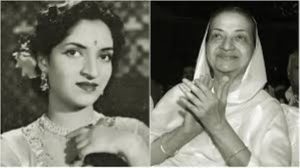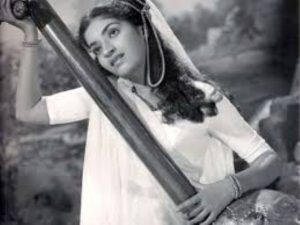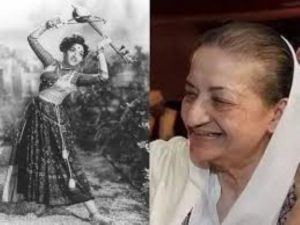Sandhya Shantaram, a legend of India’s golden era

Sandhya Shantaram—born Vijaya Deshmukh—stands as one of the most enchanting presences in the golden age of Indian cinema. Discovered by the visionary filmmaker V. Shantaram, she blossomed into an actress-dancer whose subtle acting, haunting voice, and magnetic stage demeanour united in performances that continue to linger in hearts decades later. She recently passed away and I had the honour and absolute privilege to be there for her last rights, this tribute honours her journey: the songs she made unforgettable, the dance she embodied, and the films that became timeless—all testaments to her legacy.
From Theatre to Silver Screen: Beginnings
Sandhya hailed from a theatre background, along with her sister Vatsala Deshmukh. Her film debut came in Amar Bhoopali (1951), a Marathi film by V. Shantaram, where she played a vocalist admired by the poet Honaji Bala. Though she had not trained formally in dance, Sandhya was asked to learn classical dance for Jhanak Jhanak Payal Baaje (1955), a move that would define her screen identity. She underwent intensive dance training, especially in Kathak, and the result was magical.
Iconic Films & Roles
- Jhanak Jhanak Payal Baaje (1955): A lavish Technicolor dance musical, this film showcased Sandhya and Kathak maestro Gopi Krishna as dancers in a competition. The film won both the National Film Award for Best Feature Film in Hindi and multiple Filmfare Awards. Her performance combined discipline, emotion, and visual poetry.
- Do Aankhen Barah Haath (1957): Sandhya played Champa, a toy-seller whose innocence and humanity reach into the lives of prisoners. The film is remembered not just for its emotional arc but for its resonant songs like “Aye Maalik Tere Bande Hum”—a hymn of faith and reform sung by Lata Mangeshkar, written by Bharat Vyas, composed by Vasant Desai.
- Navrang (1959): Perhaps one of her most celebrated works, in both acting and dance. Here, Sandhya serves as the muse—the domestic, plain wife of a poet, whom he then visualises in vivid fantasy. In the signature Holi dance “Arre Ja Re Hatt Natkhat”, she dances wearing an elephant and ghungroos, even performing masked segments embodying both feminine and masculine energies—an unusual dual character dance.
- Stree (1961): Based on the story of Shakuntala from the Mahabharata, this film pushed Sandhya into boundary-testing territory. For scenes with lions in the forest, she didn’t use a body double. She trained in proximity with lion tamers, braving the wild to bring authenticity to her role.
- Pinjara (1972) (Marathi/Hindi): One of her last major roles. She plays Chandrakala, a tamasha artiste (folk theatre dancer), who falls in love with a morally strict school teacher—played by Shriram Lagoo in his debut. The film’s music and dance are powerful, especially in the lavni numbers. Pinjara also marked a turning point in Marathi cinema—that it could be made in colour and reach wide acclaim.
Songs & Dance: The Heartbeat of Her Legacy
Sandhya’s contribution was not just acting but bringing dance and song together in cinematic forms that felt alive:
- “Arre Ja Re Hatt Natkhat” (Navrang): The Holi dance that remains iconic. The song’s colour, rhythm, theatricality, and Sandhya’s ability to move gracefully even as she switched roles (woman/masculine mask) made this performance unforgettable.
- Do Aankhen Barah Haath songs: “Aye Maalik Tere Bande Hum” stands out as a moral, spiritual touchstone. Sandhya’s role complements the songs’ deeply human message—rehabilitation, compassion, redemption.
- In Jhanak Jhanak Payal Baaje: The classical numbers and competitive dances, including “Nain Se Nain Nahin Milao” and “Suno Suno More Rasiya”, highlighted Sandhya’s discipline after her training—she didn’t play a passive role, she danced with precision and emotion.
- Amar Bhoopali: The song “Ghanshyama Sundara” and the lavni-picturisations like Latpat Latpat Tuzha Chalane display another dance tradition—the lavni—and Sandhya’s capability to adapt style, tone, and energy.
Artistry & Courage
What makes Sandhya exceptional is not merely her talent, but her commitment:
- She took risks: real lions, dangerous dance sequences, performing parts that required both feminine and masculine energies in dance, sometimes working without body doubles.
- She was selective: most of her work was in films directed by V. Shantaram. This loyalty meant her roles were always crafted carefully, allowing her to grow in a certain style rather than chasing mass popularity at the cost of artistic depth.
- She balanced acting, dance, music, and visual storytelling: In every frame she appeared, the song‐dance was not a break from narrative—it was part of who the character was. Her performances spoke through her eyes, her hands, her movement, not just words.
Enduring Impact
Though her screen presence gradually reduced after Pinjara, the works she left behind continue to be studied, cherished, revisited. Film-historians regard Jhanak Jhanak Payal Baaje, Navrang, Do Aankhen Barah Haath, Pinjara among the classics of both Hindi and Marathi cinema. Her style of dance-song picturisation set high standards. Young actors, dancers, choreographers continue to draw inspiration from the way she inhabited her roles.
In Place of a Goodbye
If, hypothetically, one were writing a farewell, it would be with gratitude:
To Sandhya Shantaram, for every poised twirl, every expressive glance, every song that carried more than melody—a reflection of grace and artistry. She taught us that dance on screen is not mere spectacle; it is character, courage, beauty. Her films remain, timeless, and when one watches Navrang or Do Aankhen Barah Haath, one does not just see Sandhya Shantaram—one feels the person she was: dedicated, artistic, fearless.
Her legacy endures—as art does—beyond time, beyond remembrance. In every footfall echo of ghungroos, every note of a classical song, she lives.
Sandip Soparrkar holds a doctorate in world mythology folklore from Pacific University USA, an honorary doctorate in performing arts from the National American University, He is a World Book Record holder, a well-known Ballroom dancer and a Bollywood choreographer who has been honored with three National Excellence awards, one National Achievement Award and Dada Saheb Phalke award by the Government of India. He can be contacted on sandipsoparrkar06@gmail.com





